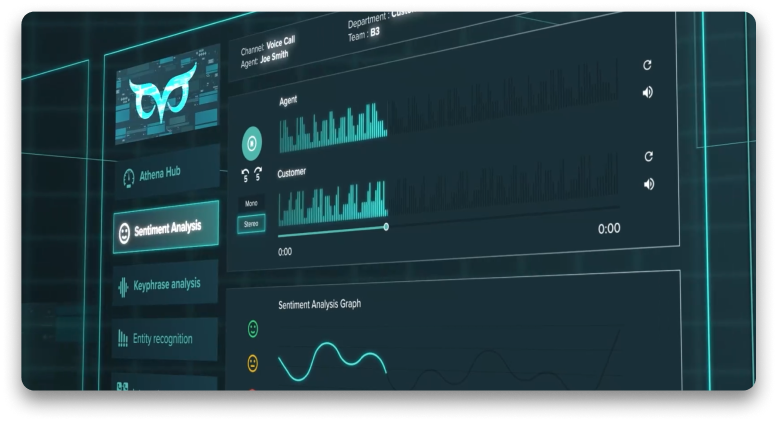Customer Interaction Management
In today’s competitive business environment, cultivating strong relationships with customers has never been more crucial. Customer Interaction Management (CIM) is essential for this purpose.
Customer Interaction Management oversees interactions throughout the customer journey, aiming for proactive communication and efficient feedback mechanisms. It sees each interaction as an opportunity to build connections and improve offerings, facilitating communication across multiple channels. This approach enhances user experience and strengthens customer relationships.
You might already know that the customer experience goes beyond a single sale—it’s something businesses should always be trying to make better. When you go the extra mile for your customers, it makes them feel good about supporting your business. People reach out to businesses for different reasons, whether it’s for marketing, sales, or customer service. But whatever the reason, each interaction is a chance for your brand to make customers happy and keep them coming back.
By grasping and implementing CIM strategies, businesses can ensure that every customer interaction is meaningful, enrich their customer engagement, bolster retention rates, and ultimately propel business growth.
This article will delve into the concept of CIM, its constituents, strategies for enhancement, and its profound impact on business relationships. For starters, let’s consider the concept we’re exploring: what is the definition of Customer Interaction Management?
What is Customer Interaction Management?
Customer Interaction Management is a set of strategies aimed at overseeing customer interactions throughout their journey with a business. It encompasses proactive communication, meticulous data analysis, and efficient feedback mechanisms. By streamlining these interactions, businesses can gain deeper insights into their customers’ needs, enhance product and service offerings, and establish enduring relationships.
Central to Customer Interaction Management is the recognition that every interaction with a customer serves as an opportunity to foster a connection. Whether through phone calls, emails, or face-to-face meetings, each touchpoint is intentionally designed to leave a positive impression on the customer.
This strategy enables businesses to facilitate customer communications across various channels, such as self-service portals, chatbots, SMS, phone calls, email, and messaging platforms. When support teams prioritise Customer Interaction Management, it elevates the user experience and cultivates strong customer relationships across all touchpoints.
Companies can achieve outstanding communication with customers by focusing on tracking and measuring every interaction customers have with their brand. This includes being attentive to touchpoints throughout the customer journey and ensuring that each one is effectively monitored. Building exceptional communication skills requires dedication, training, and time. To kickstart the development of long-lasting and trusting relationships with customers, companies should consider implementing five essential elements that lay the groundwork for effective communication strategies.
CIM cs CRM: What’s the difference?
Sometimes, the distinction between Customer Relationship Management and Customer Relationship Management (CRM) is not entirely clear. Let’s try to understand the difference between the two.
Customer Relationship Management (CRM) revolves around fostering and maintaining relationships with customers across their lifecycle. It encompasses activities such as monitoring customer interactions, handling leads and opportunities, storing customer data, and analysing behaviour to enhance relationships and boost sales. CRM systems often feature functionalities like contact management, sales automation, marketing automation, and customer service/support.
On the other hand, Customer Interaction Management (CIM) focuses more narrowly on overseeing individual interactions with customers across various communication channels. CIM involves managing these interactions in real-time or near real-time, spanning channels like phone, email, chat, social media, and others. CIM systems typically prioritise capabilities such as omnichannel communication, interaction routing and queuing, agent scripting, and analytics to optimise each interaction.
In essence, CRM emphasises the holistic management and nurturing of customer relationships, while CIM is more centred on managing discrete interactions with customers across diverse channels. Both CIM and CRM play pivotal roles in delivering exceptional customer experiences and sustaining robust customer relationships. Many businesses opt to integrate CIM functionalities into their CRM systems to provide a comprehensive solution for managing both customer relationships and individual interactions.
Why is Customer Interaction Management so important?
Effective Customer Interaction Management is imperative for businesses striving to thrive in today’s fiercely competitive marketplace. By placing a premium on customer interactions, businesses can glean invaluable insights, elevate customer satisfaction levels, and cultivate unwavering brand loyalty.
One pivotal aspect of Customer Interaction Management lies in the ability to gather and meticulously analyse customer data. Through the tracking of interactions and the collection of feedback, organisations can attain a profound understanding of their customers’ preferences, pain points, and expectations. This wealth of data serves as a compass for making well-informed business decisions and tailoring products and services to cater to the individual needs of customers.
Furthermore, enhancing customer satisfaction is paramount in this process. By providing timely and personalised support, businesses can ensure that their customers feel genuinely valued and cared for. This nurturing approach fosters a sense of loyalty among customers, who are more inclined to remain committed to the business and advocate for its offerings, consequently amplifying positive word-of-mouth promotion.
Moreover, the consistent delivery of exceptional customer experiences is instrumental in building and fortifying a robust brand reputation. Companies that consistently exceed customer expectations not only set themselves apart from competitors but also establish themselves as trusted industry leaders. This reputation for excellence not only attracts new customers but also solidifies the loyalty of existing ones, contributing to sustained business success and growth in the long run.
In order to achieve effective Customer Interaction Management, it’s essential to consider each and every customer journey step or, in other words, every type of customer interaction that might be relevant and susceptible to optimisation. Let’s analyse this in the next section.
Types of Customer Interactions
Requests occur when customers who use the product contact you, seeking some form of action, such as requesting the addition of new features to the product. These inquiries serve as valuable insights into identifying pain points.
Complaints arise when individuals encounter significant issues with a product, prompting them to bring it to your team’s attention. These instances present opportunities to uncover common flaws in your products or processes.
Compliments occur when satisfied customers take the initiative to praise your brand. Such interactions offer prime opportunities to express gratitude for their support and encourage them to leave positive reviews.
Questions emerge when people reach out to gather information about your product or service. These inquiries serve as opportunities to identify areas where your current product communications may be lacking, such as identifying unanswered questions in your product or marketing communications.
Customer Interaction Management is all about implementing different processes and guidelines to best handle and integrate all those types of interactions. We’ll see some of these processes in the next section.
Key Elements of Efficient Customer Interactions
What skills and practices are necessary for exceptional communication with customers?
Exceptional communication with customers requires skills such as active listening, the ability to provide personalized communication, developing admirable customer service speed, investing in multichannel interactions, and ensuring data transparency and privacy.
How can companies start building long-lasting and trustful relationships with users today?
Companies can begin building long-lasting and trustful relationships with users today by focusing on active listening, personalizing communication, improving customer service speed, engaging in multichannel interactions, and prioritizing data transparency and privacy.
What are the essential elements for developing outstanding communication with customers?
The essential elements for developing outstanding communication with customers include practicing active listening, providing personalized communication, developing admirable customer service speed, investing in multichannel customer interactions, and ensuring data transparency and privacy.
Essential Customer Interaction Management Components
Effectively engaging with customers in CIM relies on utilising a variety of communication channels. These channels encompass traditional methods such as phone calls and face-to-face interactions, as well as digital platforms like email, social media, and live chat. Employing Omnichannel strategies enables businesses to connect with customers where they prefer, facilitating personalised experiences.
For instance, a retail store might offer in-store customer service representatives for face-to-face assistance, along with a dedicated hotline for inquiries and an active social media presence. Another example is a contact centre handling all customer interactions within one single hub thanks to an Omnichannel software solution, enabling agents to keep track of conversations across channels catering to customers’ preferences.
Data Analytics
Data holds significant importance in CIM. By gathering and analysing customer data, businesses gain valuable insights into preferences, behaviour patterns, and pain points. This data-driven approach enables tailored interactions and offerings to meet specific customer needs, thereby enhancing overall experiences.
For example, an e-commerce company may analyse customer purchase history, browsing behaviour, and demographic data to identify trends and preferences. This information helps personalise marketing, recommend products, and provide targeted support.
Data analysis also aids in anticipating customer needs and addressing potential issues proactively. Through predictive analytics, companies can identify churn risks and take preemptive measures to retain customers.
Some Customer Interaction Management platforms provide the capability to comprehensively track and monitor customer behavior and sentiment by analyzing their interactions with agents. This offers invaluable insights into both customer behavior and staff performance, making it an invaluable feature for optimal Workforce Management.
This knowledge aids in gaining a deeper understanding of how customers perceive the business, their preferences, and areas where strategies and operations could be improved. By gathering data from various communication channels such as phone calls, emails, social media, or SMS, call centers can develop a thorough understanding of their strengths and weaknesses. This detailed insight sets the stage for enhanced strategies.
For example, Sentiment Analysis AI can discern the customer’s emotional state throughout their conversation with an agent. Understanding a customer’s preferences, dislikes, and the frequency of satisfactory outcomes in their interactions with agents can be extremely beneficial for strategy development and staff training.
Furthermore, other AI tools such as Keyphrase Analysis, Entity Recognition, and additional Sentiment Analysis capabilities can identify trends and patterns, empowering businesses to make data-driven decisions that enhance operational efficiency and cost-effectiveness.
Feedback Mechanisms
Feedback is integral for continual improvement in CIM. By actively seeking and listening to customer feedback, companies pinpoint areas for improvement and promptly address concerns. Feedback mechanisms encompass surveys, reviews, and social media monitoring. Responding to feedback demonstrates a genuine commitment to meeting customer needs.
For instance, a hotel may send post-stay surveys to guests to rate their experience and provide feedback on aspects like cleanliness and staff friendliness. This feedback, endlessly helpful for Workforce Management (WFM) approaches, informs improvement efforts to enhance guest experiences.
Moreover, businesses can use social media platforms to monitor and respond to feedback in real-time, demonstrating dedication to customer satisfaction.
But how should you go about planning and implementing these processes? While every business is different, and the specific response to that question will depend on the particular field or company, there’s a number of general steps that can be useful to any business trying to implement a Customer Interaction Management plan. Let’s go through them.
5 steps for effective Customer Interaction Management
Train your support team
Ensure your customer representatives are equipped to manage diverse customer interactions across various channels. This ensures consistency in customer experience across all communication touchpoints, fostering trust in your brand.
It’s also helpful to offer training in active listening and de-escalation strategies. A good way to do this is to facilitate regular meetings for discussing procedures and challenging scenarios, allowing them to collaboratively determine optimal approaches, or to conduct workshops to introduce new techniques and ensure they receive support during implementation.
Assuring customers of your team’s reliability in delivering professional and effective interactions enhances the likelihood of fostering satisfaction and loyalty.
Navigate difficult conversations
Frequently, your agents may encounter dissatisfied customers who express their frustrations to your support team. It’s crucial that your agents feel empowered to navigate these challenging conversations calmly and effectively.
Consider organising roleplay sessions to help agents become adept at managing intricate customer inquiries and pacifying upset customers effortlessly. It’s essential for agents to demonstrate empathy while seeking to comprehend the customer’s issue before proposing the optimal solution.
Deliver personalised experiences
Infusing a personal touch into your customer responses fosters the perception of genuine human interaction, rather than consistently receiving automated replies. Avoid excessive reliance on canned or automated responses, as this might alienate your customers.
It’s essential for your agents to master the skill of striking a balance in customer conversations by incorporating appropriate levels of personalization. While routine customer concerns can be addressed with canned responses, prioritised or delicate issues may necessitate personalised communication.
Align how teams work on different channels
Customers engaging with your brand on social media may anticipate a distinct tone in their interactions compared to those contacting you via email, SMS, or phone. It’s imperative for support agents to navigate interactions across diverse communication channels, adapting their approach to each medium appropriately. Your customer interaction management strategy should incorporate a framework that equips agents to communicate in a manner aligned with your brand and tailored to customer preferences.
When addressing customers on social media, they may anticipate a different tone in responses than those contacting you via email. Support agents should grasp these subtleties before crafting their replies, ensuring customers aren’t left feeling uneasy due to an unnatural response that doesn’t align with the medium of communication they’ve chosen.
Respond to customer feedback
By analysing customer responses to your service interactions, you can pinpoint bottlenecks in your customer engagement strategy and strive to enhance it. For instance, customers anticipate follow-ups via their preferred channel and in their native language.
Investing in a helpdesk solution that integrates with pertinent apps and CRM tools, while also offering multilingual support, can be beneficial. This setup ensures that regardless of the communication channel customers utilise, support teams can address queries and feedback from a unified platform that centralises and oversees all communications.
Benefits of Customer Interaction Management
Reduced customer churn
Effectively managing your interactions is key to cultivating enduring customer relationships. When customers feel listened to and perceive that you genuinely care, they are more likely to share their experiences openly. This allows businesses to reassess their customer satisfaction initiatives and review their current strategies.
Honest and transparent communication with customers lays the groundwork for reducing customer attrition rates and enhancing retention, and interaction analytics are an essential component of any customer service Workforce Management solution.
Insights into customer habits
Effective management of customer interactions forms the cornerstone of every thriving business. Engaging with customers empowers them to express concerns, offer feedback, and provide insights into enhancing their experience.
Positive interactions with customers facilitate the analysis of what resonates and what doesn’t with your key stakeholders. This fosters an understanding of their challenges and buying behaviours, providing real-time data on areas for improvement.
Taking a strategic approach to interactions ensures consistent communication across all channels, facilitating proactive engagement with leads and sustaining ongoing conversations. It also makes it easier to convey personalised customer experiences across all channels, a vital part of fostering good relationships with customers.
Personalization is pivotal for customer retention. Statistics show that approximately 71% of consumers expect personalised interactions, and 76% experience frustration when interactions lack personalization. Notably, companies excelling in personalization activities generate 40% more revenue than average players.
To personalise the customer experience effectively, companies should implement personalised self-service options; 81% of customers prefer resolving issues independently before seeking assistance from service agents.
Moreover, ensuring availability across various communication channels caters to diverse customer preferences, reducing friction and enhancing satisfaction. Prioritising personalised customer service across all touchpoints bolsters satisfaction and loyalty, fostering higher retention rates and increasing customer lifetime value.
Better understanding of customer pain points
Crafting an effective strategy to engage with your target audience enhances your understanding of them. By monitoring metrics related to customer calls and satisfaction, you can identify recurring patterns in their needs and frustrations.
When support agents are equipped with training to actively listen to customers, they gather more comprehensive information about obstacles or product flaws.
Identifying areas where your audience encounters challenges enables you to address them promptly, and even anticipate concerns to resolve them proactively before they escalate. These efforts collectively elevate the overall customer experience.
If you enjoyed reading this, you might also be interested in…
Call Centre Software
Customer Experience Automation
Customer Experience Management
Customer Interaction Management System
WFM (Workforce Management)
WFM Solutions



